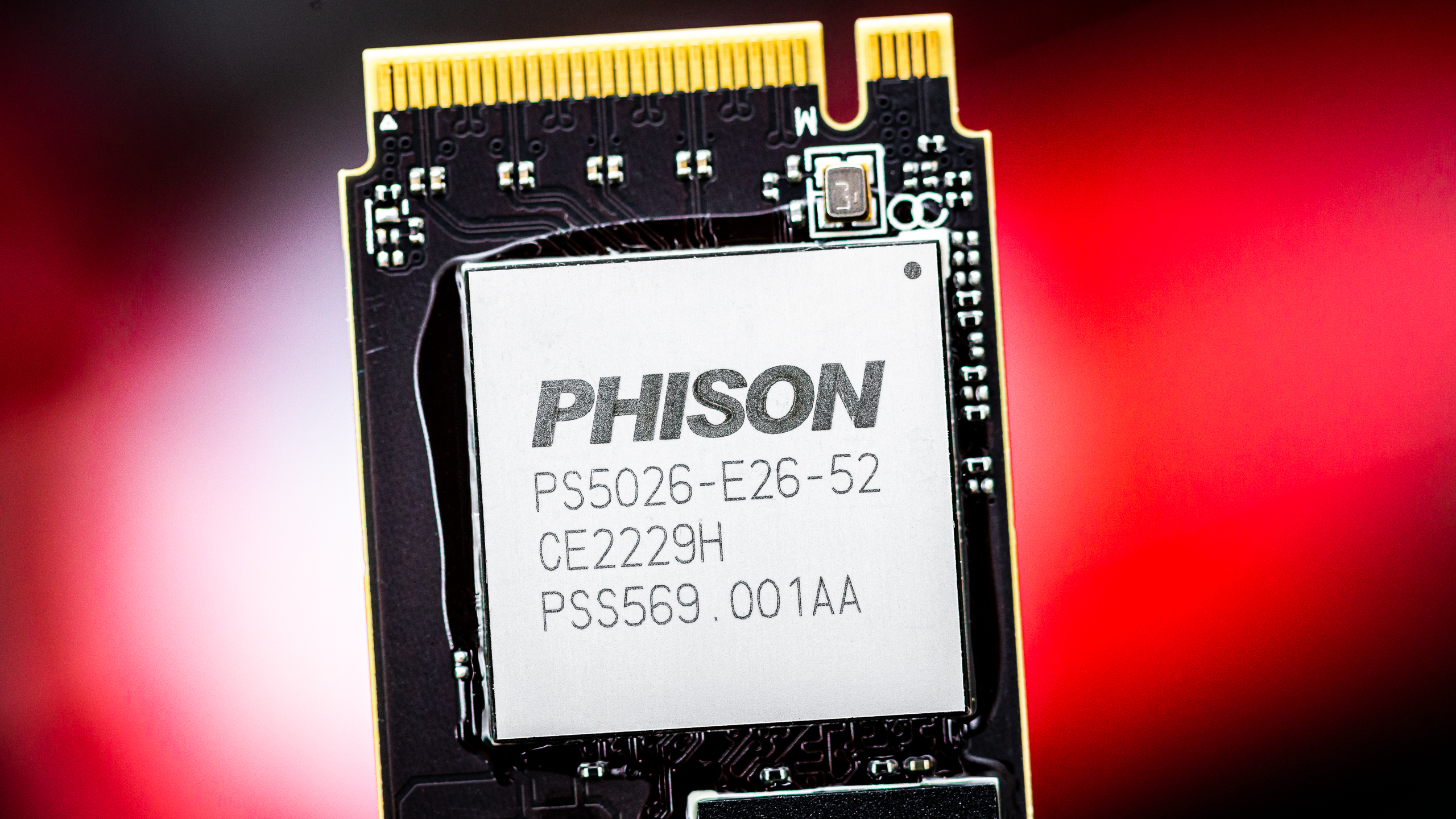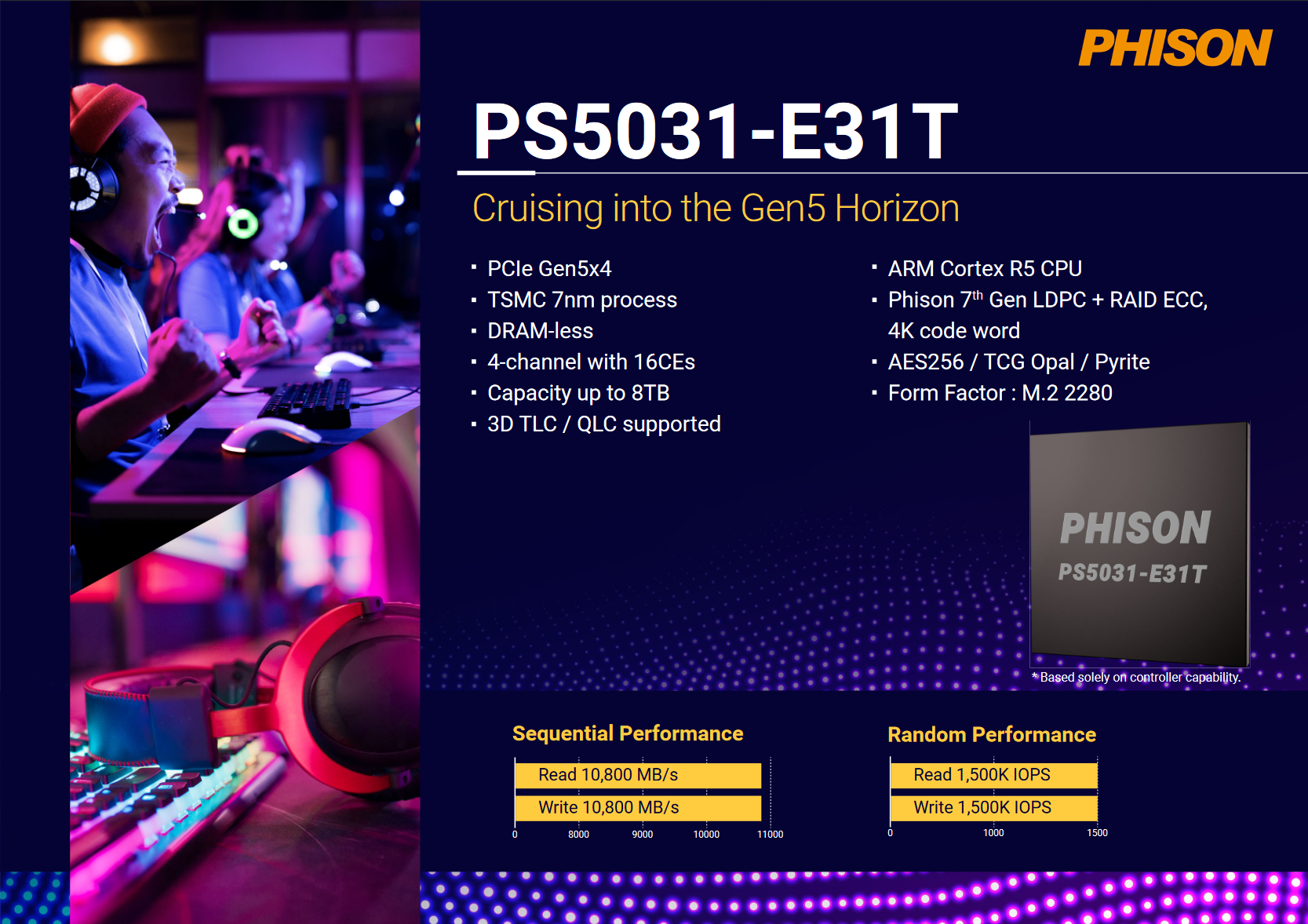Phison reveals specs for new USB 4, PCIe Gen 5 SSD hardware — more details at CES 2024
Phison will be showing off a prototype SSD that is faster than today's fastest Gen 5 SSDs at CES 2024.

Now that the year is almost over, system component manufacturers are preparing products for CES 2024, starting during the 2nd week of January. Phison has announced four products that it will showcase at its CES 2024 booth, including a new USB 4 controller, two new M.2 SSD controllers, and a prototype Gen 5 SSD featuring sequential read speeds that outperform the Best SSDs on the market today.
The two memory controllers Phison announced include the PS5031-E31T and the PS5027-E27T. The former is a low-powered M.2 PCIe Gen 5 controller featuring maximum sequential read and write speed support of up to 10,800 MB/s and random read-write performance of up to 1,500,000 IOPS. The controller is built on TSMC's 7nm process featuring a 4-channel configuration, an ARM Coretex R5 CPU, AES 256 encryption, Phison's 7th Gen LDPC, and RAID ECC. SSD support includes a maximum capacity of up to 8TB and support for 3D TLC and QLC NAND flash.

This new low-powered controller is designed to fill gaps in the market that the more powerful E26 controller can't serve. The low-powered nature of the new controller should enable it to work without the requirement of an SSD heatsink, which is very necessary for compact systems such as laptops and handheld gaming machines that cannot fit an SSD with a beefy heatsink.

The latter is another low-power PCIe Gen 4 SSD controller aimed at the 2230 form factor M.2 SSDs designed for handheld gaming machines like the Steam Deck and ROG Ally. This controller sports TSMC's older 12nm process, featuring a 4-channel configuration and what Phison calls a "Single CPU Architecture." Similar to the PS5031-E31T, this Gen 4-designed PS5027-E27T controller features 8TB storage support and supports 3D TLC and QLC NAND flash.
Sequential performance maxes out at up to 7,400MB/s for reads, and 6,700 MB/s for writes. Random performance tops out at 1,200,000 IOPS for both reads and writes. For reference, these specifications only disclose what the controller is capable of, and do not represent the actual performance specifications of SSDs that might come with this controller.
Phison will also demo its PS5026-E26 Max14um Gen5 SSD. Phison first showed off this drive a few months ago, touting it as the highest-performance client SSD to date. The drive performed at over 14GB/s in Crystal Disk Mark, making it faster than even the fastest consumer Gen 5 SSDs on the market today (like the Crucial T700). To hit these speeds, Phison used its E26 controller in conjunction with Micron 2400MT/s NAND flash, one of the only consumer memory chips to achieve these speeds. For cooling, Phison also went the extra mile and engineered a copper cooling system with two Frore Systems AirJet Minis.
Phison's E26 controller has always been capable of achieving these speeds, but Phison wanted to remind people that speeds like this are possible. The biggest problem getting in the way of that is the lack of ultra-high speed 2400MT/s memory chips that are capable of saturating the E26 controller's bandwidth capabilities. But, now that 2400MT/s are ramping up in production, we should start seeing drives with speeds of 14GB/s shortly.
Get Tom's Hardware's best news and in-depth reviews, straight to your inbox.
Finally, Phison will unveil a new USB 4 memory controller dubbed the PS2251-21 (U21). Phison states that this is the world's first USB 4 single-chip solution for portable devices and unconventional form factors. The controller is capable of speeds of up to 4GB/s.

Aaron Klotz is a contributing writer for Tom’s Hardware, covering news related to computer hardware such as CPUs, and graphics cards.
-
HideOut So if its Gen 5 and 4 channel, then it should be lots more than 7400 MB/sec. So is it 2 channel or a newer Gen 4?Reply -
CRamseyer The E31T Gen5 x4 4-channel is 10.8GB/s.Reply
Also, E26 "Max14um" is no longer a prototype. -
bit_user Reply
Look again. The article describes more than one controller. You quoted performance numbers of the slower one.HideOut said:So if its Gen 5 and 4 channel, then it should be lots more than 7400 MB/sec. So is it 2 channel or a newer Gen 4?
"The latter is another low-power PCIe Gen 4 SSD controller aimed at the 2230 form factor M.2 SSDs designed for handheld gaming machines like the Steam Deck and ROG Ally. This controller sports TSMC's older 12nm process, featuring a 4-channel configuration and what Phison calls a "Single CPU Architecture." Similar to the PS5031-E31T, this Gen 4-designed PS5027-E27T controller features 8TB storage support and supports 3D TLC and QLC NAND flash."
Here, they state the rationale for introducing a lower-end controller:
"This new low-powered controller is designed to fill gaps in the market that the more powerful E26 controller can't serve. The low-powered nature of the new controller should enable it to work without the requirement of an SSD heatsink, which is very necessary for compact systems such as laptops and handheld gaming machines that cannot fit an SSD with a beefy heatsink."
It's not a long article. If you see something eyebrow-raising enough to post about, take a few seconds and just reread it, first. I catch myself this way, more often than I'd care to admit. -
bit_user @CRamseyer can you please point me to more info about the "RAID ECC" feature/functionality? Is this something that all drives would use, or is it likely to be limited to specific drives or multi-drives configurations?Reply
Also, does "DRAM-less" mean it doesn't require DRAM, but can still accommodate some for additional performance? If used without DRAM, does that mean it would use host memory buffers (HMB)?
Thanks!